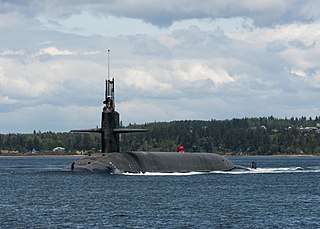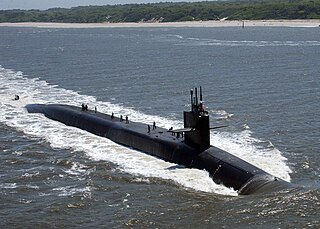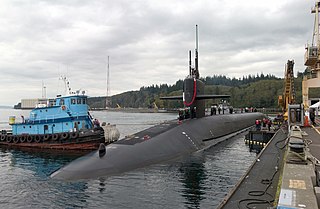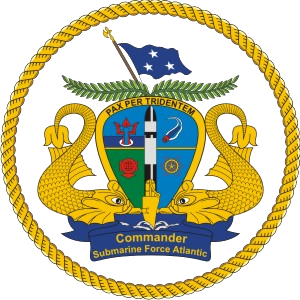
The Ohio class of nuclear-powered submarines includes the United States Navy's 14 ballistic missile submarines (SSBNs) and its four cruise missile submarines (SSGNs). Each displacing 18,750 tons submerged, the Ohio-class boats are the largest submarines ever built for the U.S. Navy. They are also the third-largest submarines ever built, behind the Russian Navy's Soviet era 48,000-ton Typhoon class, the last of which was retired in 2023, and 24,000-ton Borei class. Capable of carrying 24 Trident II missiles apiece, the Ohio class are equipped with just as many missiles as, if not more than, either the Borei class (16) or the deactivated Typhoon class (20).

USS Patrick Henry (SSBN-599), named after the American Revolutionary War figure and Founding Father Patrick Henry (1736–1799), was a George Washington class nuclear-powered fleet ballistic missile submarine of the United States Navy. She was later converted into an attack submarine and redesignated SSN-599.

USS Ohio (SSBN-726/SSGN-726), the lead boat of her class of nuclear-powered fleet ballistic missile submarines (SSBN), is the fourth vessel of the United States Navy to be named for the U.S. state of Ohio. She was commissioned with the hull designation of SSBN-726, and with her conversion to a guided missile submarine she was re-designated SSGN-726.

USS Louisiana (SSBN-743) is the 18th and last ship of the United States Navy's Ohio class of nuclear-powered fleet ballistic missile submarines. She carries Trident ballistic missiles and has been in commission since 1997. She is the fourth commissioned ship to bear the name of the U.S. state of Louisiana.

USS Michigan (SSBN-727/SSGN-727) is an Ohio-class nuclear-powered guided missile submarine (SSGN), converted from a ballistic missile submarine (SSBN), that is part of the United States Navy. She is the third vessel to bear the name of the U.S. state of Michigan.

USS Simon Bolivar (SSBN-641), a Benjamin Franklin class fleet ballistic missile submarine, was the only ship of the United States Navy to be named for Simón Bolívar (1783–1830), the Venezuelan hero of the independence movements of the former Spanish colonies in South America.

A cruise missile submarine is a submarine that carries and launches cruise missiles as its primary armament. Missiles greatly enhance a warship's ability to attack surface combatants and strike land targets; although torpedoes are a more discrete option for submerged submarines, missiles give a much longer stand-off range, shorter time to impact the target, as well as the ability to engage multiple targets on different headings at the same time. Many cruise missile submarines retain the capability to deploy nuclear warheads on their missiles, but they are considered distinct from ballistic missile submarines due to the substantial differences between the two weapons systems' flight characteristics; cruise missiles fly aerodynamically using flight surfaces like wings or fins, while a ballistic missile uses its engine power alone as it may exit the atmosphere.

USS Alabama (SSBN-731) is the sixth Ohio-class nuclear-powered ballistic missile submarine, and the seventh United States vessel to be named for the state of Alabama. The boat's motto duplicates the state's motto, Audemus Jura Nostra Defendere.

USS Florida (SSBN-728/SSGN-728), an Ohio-class cruise missile submarine, is the sixth vessel of the United States Navy to be named for the U.S. state of Florida. She was commissioned with the hull designation of SSBN-728; with her conversion to a cruise missile submarine, from a ballistic missile submarine, she was re-designated SSGN-728.

USS Nebraska (SSBN-739) is the 14th Ohio-class ballistic missile submarine, and the second United States Navy vessel to be named in honor of Nebraska, the 37th state. She carries Trident ballistic missiles.

USS Maryland (SSBN-738) is an Ohio-class submarine in the United States Navy. Maryland is the 13th of the 18 Ohio-class ballistic missile submarines, and has been in active service since 1992. Maryland is the fourth US Navy vessel to be named after the US state of Maryland. Her mission is to provide the United States government with an undetectable and unattackable nuclear launch platform in support of the national strategy of strategic deterrence. The contract for the construction of the Maryland was awarded on 14 March 1986. Her keel was laid down by the Electric Boat Division of the General Dynamics Corporation at Groton, Connecticut, on 22 April 1986.

USS Wyoming (SSBN-742) is a United States Navy Ohio-class ballistic missile submarine which has been in commission since 1996. She is the fourth US Navy ship to be named USS Wyoming, although it was only the third named after the state of Wyoming.

USS West Virginia (SSBN-736) is a United States Navy Ohio-class ballistic missile submarine. She has been in commission since 1990. She is the third U.S. Navy ship to be named for West Virginia, the 35th state, and the 11th of 18 Ohio-class submarines.

USS Alaska (SSBN-732), is a United States Navy Ohio-class ballistic missile submarine which has been in commission since 1986. She is the fourth US Navy ship to be named for the Territory or State of Alaska.

USS Francis Scott Key (SSBN-657), a Benjamin Franklin-class ballistic missile submarine, was the only submarine of the United States Navy to be named for Francis Scott Key (1779–1843), an American lawyer, author, and amateur poet who wrote the poem "The Defense of Fort McHenry", which became the words to the United States' national anthem, "The Star-Spangled Banner". During World War II there was a liberty ship named SS Francis Scott Key.

USS Casimir Pulaski (SSBN-633), a James Madison-class ballistic missile submarine, was the second ship of the United States Navy to be named for Casimir Pulaski (1745–1779), a Polish general who served in the American Revolutionary War.

USS Von Steuben (SSBN-632), a James Madison-class fleet ballistic missile submarine, was the second ship of the United States Navy to be named for Baron Friedrich Wilhelm von Steuben (1730–1794), a Prussian army officer who served in the American Revolutionary War.

Naval Submarine Base Kings Bay is a base of the United States Navy located adjacent to the city of St. Marys in Camden County, Georgia, on the East River in southeastern Georgia, and 38 miles (61 km) from Jacksonville, Florida. The Submarine Base is the U.S. Atlantic Fleet's home port for U.S. Navy Fleet ballistic missile nuclear submarines capable of being armed with Trident missile nuclear weapons. This submarine base covers about 16,000 acres of land, of which 4,000 acres are protected wetlands.
There are three major types of submarines in the United States Navy: ballistic missile submarines, attack submarines, and cruise missile submarines. All submarines currently in the U.S. Navy are nuclear-powered. Ballistic missile submarines have a single strategic mission of carrying nuclear submarine-launched ballistic missiles. Attack submarines have several tactical missions, including sinking ships and subs, launching cruise missiles, and gathering intelligence. Cruise missile submarines perform many of the same missions as attack submarines, but with a focus on their ability to carry and launch larger quantities of cruise missiles than typical attack submarines.

The Commander, Submarine Force Atlantic (COMSUBLANT) is the Submarine Force U.S. Atlantic Fleet type commander under the United States Fleet Forces Command.





















